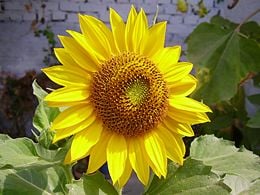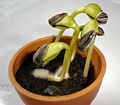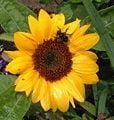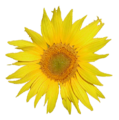Difference between revisions of "Sunflower" - New World Encyclopedia
({{Contracted}}) |
Rick Swarts (talk | contribs) (added article from Wikipedia and credit/category tags) |
||
| Line 1: | Line 1: | ||
{{Claimed}}{{Contracted}} | {{Claimed}}{{Contracted}} | ||
| + | |||
| + | {{Taxobox | ||
| + | | color = lightgreen | ||
| + | | name = Sunflower | ||
| + | | image = W&Asunflower.jpg | ||
| + | | image_width = 260px | ||
| + | | image_caption = | ||
| + | | regnum = [[Plantae]] | ||
| + | | division = [[Flowering plant|Magnoliophyta]] | ||
| + | | classis = [[Magnoliopsida]] | ||
| + | | ordo = [[Asterales]] | ||
| + | | familia = [[Asteraceae]] | ||
| + | | genus = ''[[Helianthus]]'' | ||
| + | | species = '''''H. annuus''''' | ||
| + | | binomial = ''Helianthus annuus'' | ||
| + | | binomial_authority = [[Carolus Linnaeus|L.]] | ||
| + | }} | ||
| + | |||
| + | The '''sunflower''' ('''''Helianthus annuus''''') is an [[annual plant]] native to the Americas in the family [[Asteraceae]], with a large flowering head ([[inflorescence]]). The stem of the flower can grow as high as 3 [[metre]]s tall, with the flower head reaching up to 30 cm in diameter with the "large" seeds. The term "sunflower" is also used to refer to all plants of the [[genus]] ''[[Helianthus]]'', many of which are [[perennial plant]]s. | ||
| + | |||
| + | ==Description== | ||
| + | |||
| + | What is usually called the [[flower]] is actually a ''[[inflorescence|head]]'' (formally ''composite flower'') of numerous flowers (''florets'') crowded together. The outer flowers are the ''ray florets'' and can be [[yellow]], [[Maroon (color)|maroon]], [[Orange (colour)|orange]], or other [[color]]s, and are sterile. The florets inside the circular head are called ''disc florets''. The disc florets mature into what are traditionally called "[[sunflower seed]]s", but are actually the [[fruit]] (an ''[[achene]]'') of the plant. The true seeds are encased in an inedible husk. | ||
| + | |||
| + | The florets within this cluster are arranged spirally. Typically each floret is oriented toward the next by approximately the [[golden angle]], producing a pattern of interconnecting [[spiral]]s where the number of left spirals and the number of right spirals are successive [[Fibonacci number]]s. Typically, there are 34 spirals in 1 direction and 55 in the other; on a very large sunflower you may see 89 in one direction and 144 in the other. | ||
| + | |||
| + | [[Image:Helianthus whorl.jpg|thumb|Sunflower head displaying florets in spirals of 34 and 55 around the outside]] | ||
| + | |||
| + | ==Heliotropism== | ||
| + | |||
| + | Sunflowers in the [[bud]] stage exhibit [[heliotropism]]. At sunrise, the faces of most sunflowers are turned towards the east. Over the course of the day, they move to track the sun from east to west, while at night they return to an eastward orientation. This motion is performed by motor cells in the pulvinus, a flexible segment of the stem just below the bud. As the bud stage ends, the stem stiffens and the blooming stage is reached. | ||
| + | |||
| + | Sunflowers in the blooming stage are not heliotropic anymore. The stem has frozen, typically in an eastward orientation. The stem and leaves lose their green color. | ||
| + | |||
| + | The wild sunflower typically does not turn toward the sun; its flowering heads may face many directions when mature. However, the leaves typically exhibit some heliotropism. | ||
| + | |||
| + | ==Cultivation and uses== | ||
| + | [[Image:sunflower farm.jpg|thumb|280px|A sunflower farm near [[Mysore]], India.]] | ||
| + | [[Image:Sunflower head snack.jpg|thumb|280px|Sunflower heads sold as [[snack food|snack]]s in China.]] | ||
| + | |||
| + | Sunflowers are native to the [[Americas]]. There is some debate about where the sunflower was first domesticated. The earliest known examples of a fully domesticated sunflower were found at the [[Hayes]] site in Tennessee and date back to around 2300 B.C.E. There were also other remains found at the [[Olmec]] site of [[San Andrés (Mesoamerican site)|San Andrés]] dating some time before 2100 B.C.E. The [[Tahuantinsuyu|Incas]] used the sunflower as an image of their [[Solar deity|sun god]]. [[Gold]] images of the flower, as well as [[seed]]s, were taken back to [[Europe]] early in the [[16th century]]. | ||
| + | |||
| + | To grow well, sunflowers need full sun. They grow best in fertile, moist, well-[[drainage|drained]] [[soil]] with a lot of [[mulch]]. In commercial planting, seeds are planted 45 cm (1.5') apart and 2.5 cm (1") deep. | ||
| + | |||
| + | Sunflower "whole seed" (fruit) are sold as a snack food after roasting within heated ovens with or without salt added. Sunflowers can be processed into a [[peanut butter]] alternative, [[Sunbutter]], especially in [[China]], [[Russia]], the [[United States]], the [[Middle East]] and [[Europe]]. | ||
| + | It is also sold as food for [[bird]]s and can be used directly in cooking and [[salads]]. | ||
| + | |||
| + | [[Sunflower oil]], extracted from the [[Sunflower seed|seeds]], is [[Cooking oil|used for cooking]], as a [[carrier oil]] and to produce [[biodiesel]], for which it is less expensive than the [[olive]] product. A range of sunflower varieties exist with differing fatty acid compositions; some 'high oleic' types contain a higher level of healthy monounsaturated fats in their oil than even [[olive oil]]. | ||
| + | |||
| + | During the 18th Century, the use of sunflower oil became very popular in Europe, particularly with members of the Russian Orthodox Church because sunflower oil was one of the few oils that was not prohibited during Lent. | ||
| + | |||
| + | The cake remaining after the seeds have been processed for oil is used as a [[livestock]] feed. Some recently developed [[cultivar]]s have drooping heads. These cultivars are less attractive to [[Gardening|gardeners]] growing the flowers as [[ornamental plant]]s, but appeal to [[farmer]]s, because they reduce [[bird]] damage and losses from some [[phytopathology|plant disease]]s. Sunflowers also produce [[latex]] and are the subject of experiments to improve their suitability as an alternative crop for producing [[hypoallergenic]] [[rubber]]. | ||
| + | |||
| + | For farmers growing other crops, the sunflower is considered a [[weed]]. The wild variety will grow unwanted in corn and soybean fields and can have a negative impact on yields. | ||
| + | |||
| + | ==Mathematical model== | ||
| + | [[Image:SunflowerModel.svg|thumb|100px|Illustration of Vogel's model for ''n''=1..500 .]] | ||
| + | A model for the pattern of [[floret]]s in the head of a sunflower was proposed by H Vogel. This is expressed in [[polar coordinates]] | ||
| + | :<math>r = c \sqrt{n}</math>, | ||
| + | :<math>\theta = n \times 137.5^{\circ}</math>, | ||
| + | where θ is the angle, ''r'' is the radius or distance from the center, and ''n'' is the index number of the floret and ''c'' is a constant scaling factor. It is a form of [[Fermat's spiral]]. The angle 137.5° is related to the [[golden ratio]] and gives a close packing of florets. This model has been used to produce computer graphics representations of sunflowers. <ref>{{cite book | ||
| + | | last =Prusinkiewicz | ||
| + | | first =Przemyslaw | ||
| + | | authorlink =Przemyslaw Prusinkiewicz | ||
| + | | coauthors =[[Aristid Lindenmayer|Lindenmayer, Aristid]] | ||
| + | | title =[[The Algorithmic Beauty of Plants]] | ||
| + | | publisher =Springer-Verlag | ||
| + | | date =1990 | ||
| + | | location = | ||
| + | | pages =101-107 | ||
| + | | url =http://algorithmicbotany.org/papers/#webdocs | ||
| + | | doi = | ||
| + | | id = ISBN 978-0387972978 }}</ref> | ||
| + | |||
| + | ==Size== | ||
| + | Sunflowers most commonly grow to heights between 2.5 and 3.5 [[meter|m]] (8 - 12[[feet|']]). Scientific literature reports, from [[1567]], that a 12 m (40'), traditional, single-head, sunflower plant was grown in [[Padua]]. The same seed lot grew almost 8 m (24') at other times and places (e.g. [[Madrid]]). Much more recent feats (past score years) of over 8 m (25') have been achieved in both [[Netherlands]] and [[Ontario]], [[Canada]]. | ||
| + | |||
| + | ==Cultural usage== | ||
| + | *The sunflower is the state flower of the U.S. state of [[Kansas]], and one of the city flowers of [[Kitakyushu]], [[Japan]]. | ||
| + | *The sunflower is often used as a symbol of [[green ideology]], much as the red [[rose]] is a symbol of [[socialism]] or [[social democracy]]. The sunflower is also the symbol of the [[Vegan Society]]. | ||
| + | |||
| + | ==Other species== | ||
| + | *The [[Jerusalem artichoke]] (''Helianthus tuberosa'') is related to the sunflower. | ||
| + | *The '''Mexican sunflower''' is ''Tithonia rotundifolia''. | ||
| + | *'''False sunflower''' refers to plants of the genus ''Heliopsis''. | ||
| + | |||
| + | ==Flower formation== | ||
| + | <gallery> | ||
| + | Image:Sunflower opening 1-KayEss-2.jpeg|1. The first stage of the flower formation | ||
| + | Image:Sunflower opening 2-KayEss-2.jpeg|2. The flower is still covered, but faces the sun | ||
| + | Image:Sunflower opening 3-KayEss-1.jpeg|3. The flower is nearly completely exposed | ||
| + | Image:Sunflower opening 4-KayEss-2.jpeg|4. The flower is completely exposed | ||
| + | </gallery> | ||
| + | |||
| + | {{Video|filename=Sunflower Flower Opening Time Lapse.ogg|title=Sunflower opening|description=Time lapse video of a sunflower opening over an 8.75 hour period.}} | ||
| + | {{-}} | ||
| + | |||
| + | ==Gallery== | ||
| + | <gallery> | ||
| + | Image:IMG_8165.jpg|Sunflowers in [[Memphis, Tennessee]] grown as crop | ||
| + | Image:Wilkesboro Sunflower.JPG|Sunflowers in [[Wilkesboro, North Carolina]] | ||
| + | Image:Sunflowerswilting.jpg|Sunflowers in Manila, Philippines | ||
| + | Image:100 2119.jpg|Sunflowers | ||
| + | Image:Sunflower_Bumbebee.jpg|Bumble bee sampling Sunflower nectar | ||
| + | image:Sunflowers.jpg|Sunflowers growing near [[Fargo, North Dakota]] | ||
| + | Image:Sunflower DSC01056.jpg|Lone sunflower about 2 m (6 ft, 6') tall | ||
| + | Image:Sunflower seedlings.jpg|Sunflower seedlings, just three days after germination | ||
| + | Image:Sunflowers Bulgaria 2.jpg|Sunflower field in Eastern [[Bulgaria]] | ||
| + | Image:Sunflower-Louisiana.png|Sunflower Profile | ||
| + | Image:Sunflower3a.JPG|Sunflower and [[Bee|pollinator]] | ||
| + | Image:Tournesol.png|Sunflower ([[French language|French]]:''Tournesol'') from [[MediaWiki]] logo | ||
| + | Image:Sunflower10094.jpg|Large Russian Sunflower | ||
| + | Image:Sunflower 3 bg 052204.jpg|Sunflower | ||
| + | Image:SunflowerwithBee.JPG|Close-up of sunflower. | ||
| + | Image:Helianthus annuus stamper.jpg|The Netherlands, June 2006 | ||
| + | Image:Sunflower field Geneva.JPG|A field of Sunflowers in the [[Canton de Genève]] in [[Switzerland]] | ||
| + | Image:Sunflower-fruiting_head.jpg|Fruiting head | ||
| + | Image:Sunflower_seeds.jpg|Sunflower seeds in many variations and sizes. | ||
| + | Image:Tournesol JPG01.jpg|Sunflower close-up. | ||
| + | Image:Red_sunflowers.jpg|Red sunflowers. | ||
| + | Image:Sonnenblume Sunflower.JPG|Hybrid Sunflower | ||
| + | Image:Sunflowergarden.JPG|Small Sunflower | ||
| + | Image:SunFlower1.jpg|Sunflower Macro | ||
| + | </gallery> | ||
| + | {{-}} | ||
| + | |||
| + | ==See also== | ||
| + | *[[wikt:sheller|Sheller]] | ||
| + | *[[Red sunflower]] | ||
| + | |||
| + | ==Notes== | ||
| + | <div class="references-small"><references/></div> | ||
| + | |||
| + | == References == | ||
| + | *Pope, Kevin; Pohl, Mary E. D.; Jones, John G.; Lentz, 3 David L.; von Nagy, Christopher; Vega, Francisco J.; Quitmyer Irvy R.; "[http://www.sciencemag.org/cgi/content/full/292/5520/1370 Origin and Environmental Setting of Ancient Agriculture in the Lowlands of Mesoamerica]", ''[[Science (journal)|Science]]'', 18 May 2001:Vol. 292. no. 5520, pp. 1370 - 1373. | ||
| + | * Shosteck, Robt. 1974. ''Flowers and Plants. An International Lexicon with Biographical Notes''. Quadrangle/The New York Times Book Co. 329 pp. | ||
| + | * Wood, Marcia. June 2002. "Sunflower Rubber?" Agricultural Research. USDA. [http://www.ars.usda.gov/is/AR/archive/jun02/rubber0602.htm] | ||
| + | |||
| + | == External links == | ||
| + | *[http://www.sunflowernsa.com/ National Sunflower Association] | ||
| + | *[http://car.pege.org/2005-vegetable-oil/ A farmer running his tractor and car with sunflower oil] | ||
| + | *[http://www.everypoet.com/archive/poetry/william_blake/william_blake_songs_of_experience_ah_sunflower.htm William Blake's poem, "Ah! The sunflower."] | ||
| + | *[http://boppin.com/sunflower.html Allen Ginsberg's poem, "Sunflower Sutra."] | ||
| + | |||
| + | [[Category:Life sciences]] | ||
| + | [[Category:Plants]] | ||
| + | {{credit|Sunflower|159244815}} | ||
Revision as of 21:14, 24 September 2007
| Sunflower | ||||||||||||
|---|---|---|---|---|---|---|---|---|---|---|---|---|
 | ||||||||||||
| Scientific classification | ||||||||||||
| ||||||||||||
| Helianthus annuus L. |
The sunflower (Helianthus annuus) is an annual plant native to the Americas in the family Asteraceae, with a large flowering head (inflorescence). The stem of the flower can grow as high as 3 metres tall, with the flower head reaching up to 30 cm in diameter with the "large" seeds. The term "sunflower" is also used to refer to all plants of the genus Helianthus, many of which are perennial plants.
Description
What is usually called the flower is actually a head (formally composite flower) of numerous flowers (florets) crowded together. The outer flowers are the ray florets and can be yellow, maroon, orange, or other colors, and are sterile. The florets inside the circular head are called disc florets. The disc florets mature into what are traditionally called "sunflower seeds", but are actually the fruit (an achene) of the plant. The true seeds are encased in an inedible husk.
The florets within this cluster are arranged spirally. Typically each floret is oriented toward the next by approximately the golden angle, producing a pattern of interconnecting spirals where the number of left spirals and the number of right spirals are successive Fibonacci numbers. Typically, there are 34 spirals in 1 direction and 55 in the other; on a very large sunflower you may see 89 in one direction and 144 in the other.
Heliotropism
Sunflowers in the bud stage exhibit heliotropism. At sunrise, the faces of most sunflowers are turned towards the east. Over the course of the day, they move to track the sun from east to west, while at night they return to an eastward orientation. This motion is performed by motor cells in the pulvinus, a flexible segment of the stem just below the bud. As the bud stage ends, the stem stiffens and the blooming stage is reached.
Sunflowers in the blooming stage are not heliotropic anymore. The stem has frozen, typically in an eastward orientation. The stem and leaves lose their green color.
The wild sunflower typically does not turn toward the sun; its flowering heads may face many directions when mature. However, the leaves typically exhibit some heliotropism.
Cultivation and uses
Sunflowers are native to the Americas. There is some debate about where the sunflower was first domesticated. The earliest known examples of a fully domesticated sunflower were found at the Hayes site in Tennessee and date back to around 2300 B.C.E. There were also other remains found at the Olmec site of San Andrés dating some time before 2100 B.C.E. The Incas used the sunflower as an image of their sun god. Gold images of the flower, as well as seeds, were taken back to Europe early in the 16th century.
To grow well, sunflowers need full sun. They grow best in fertile, moist, well-drained soil with a lot of mulch. In commercial planting, seeds are planted 45 cm (1.5') apart and 2.5 cm (1") deep.
Sunflower "whole seed" (fruit) are sold as a snack food after roasting within heated ovens with or without salt added. Sunflowers can be processed into a peanut butter alternative, Sunbutter, especially in China, Russia, the United States, the Middle East and Europe. It is also sold as food for birds and can be used directly in cooking and salads.
Sunflower oil, extracted from the seeds, is used for cooking, as a carrier oil and to produce biodiesel, for which it is less expensive than the olive product. A range of sunflower varieties exist with differing fatty acid compositions; some 'high oleic' types contain a higher level of healthy monounsaturated fats in their oil than even olive oil.
During the 18th Century, the use of sunflower oil became very popular in Europe, particularly with members of the Russian Orthodox Church because sunflower oil was one of the few oils that was not prohibited during Lent.
The cake remaining after the seeds have been processed for oil is used as a livestock feed. Some recently developed cultivars have drooping heads. These cultivars are less attractive to gardeners growing the flowers as ornamental plants, but appeal to farmers, because they reduce bird damage and losses from some plant diseases. Sunflowers also produce latex and are the subject of experiments to improve their suitability as an alternative crop for producing hypoallergenic rubber.
For farmers growing other crops, the sunflower is considered a weed. The wild variety will grow unwanted in corn and soybean fields and can have a negative impact on yields.
Mathematical model
A model for the pattern of florets in the head of a sunflower was proposed by H Vogel. This is expressed in polar coordinates
- ,
- ,
where θ is the angle, r is the radius or distance from the center, and n is the index number of the floret and c is a constant scaling factor. It is a form of Fermat's spiral. The angle 137.5° is related to the golden ratio and gives a close packing of florets. This model has been used to produce computer graphics representations of sunflowers. [1]
Size
Sunflowers most commonly grow to heights between 2.5 and 3.5 m (8 - 12'). Scientific literature reports, from 1567, that a 12 m (40'), traditional, single-head, sunflower plant was grown in Padua. The same seed lot grew almost 8 m (24') at other times and places (e.g. Madrid). Much more recent feats (past score years) of over 8 m (25') have been achieved in both Netherlands and Ontario, Canada.
Cultural usage
- The sunflower is the state flower of the U.S. state of Kansas, and one of the city flowers of Kitakyushu, Japan.
- The sunflower is often used as a symbol of green ideology, much as the red rose is a symbol of socialism or social democracy. The sunflower is also the symbol of the Vegan Society.
Other species
- The Jerusalem artichoke (Helianthus tuberosa) is related to the sunflower.
- The Mexican sunflower is Tithonia rotundifolia.
- False sunflower refers to plants of the genus Heliopsis.
Flower formation
|
Gallery
- IMG 8165.jpg
Sunflowers in Memphis, Tennessee grown as crop
- 100 2119.jpg
Sunflowers
- Sunflowers Bulgaria 2.jpg
Sunflower field in Eastern Bulgaria
Sunflower and pollinator
- Sunflower 3 bg 052204.jpg
Sunflower
- Sunflower field Geneva.JPG
A field of Sunflowers in the Canton de Genève in Switzerland
See also
- Sheller
- Red sunflower
Notes
- ↑ Prusinkiewicz, Przemyslaw and Lindenmayer, Aristid (1990). The Algorithmic Beauty of Plants. Springer-Verlag, 101-107. ISBN 978-0387972978.
ReferencesISBN links support NWE through referral fees
- Pope, Kevin; Pohl, Mary E. D.; Jones, John G.; Lentz, 3 David L.; von Nagy, Christopher; Vega, Francisco J.; Quitmyer Irvy R.; "Origin and Environmental Setting of Ancient Agriculture in the Lowlands of Mesoamerica", Science, 18 May 2001:Vol. 292. no. 5520, pp. 1370 - 1373.
- Shosteck, Robt. 1974. Flowers and Plants. An International Lexicon with Biographical Notes. Quadrangle/The New York Times Book Co. 329 pp.
- Wood, Marcia. June 2002. "Sunflower Rubber?" Agricultural Research. USDA. [1]
External links
- National Sunflower Association
- A farmer running his tractor and car with sunflower oil
- William Blake's poem, "Ah! The sunflower."
- Allen Ginsberg's poem, "Sunflower Sutra."
Credits
New World Encyclopedia writers and editors rewrote and completed the Wikipedia article in accordance with New World Encyclopedia standards. This article abides by terms of the Creative Commons CC-by-sa 3.0 License (CC-by-sa), which may be used and disseminated with proper attribution. Credit is due under the terms of this license that can reference both the New World Encyclopedia contributors and the selfless volunteer contributors of the Wikimedia Foundation. To cite this article click here for a list of acceptable citing formats.The history of earlier contributions by wikipedians is accessible to researchers here:
The history of this article since it was imported to New World Encyclopedia:
Note: Some restrictions may apply to use of individual images which are separately licensed.




























